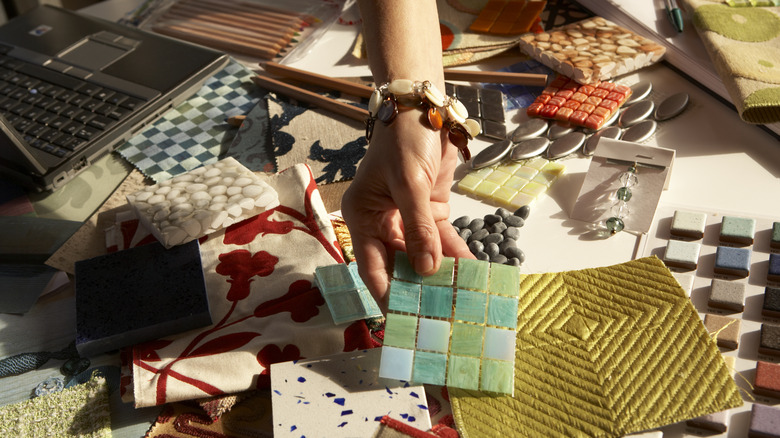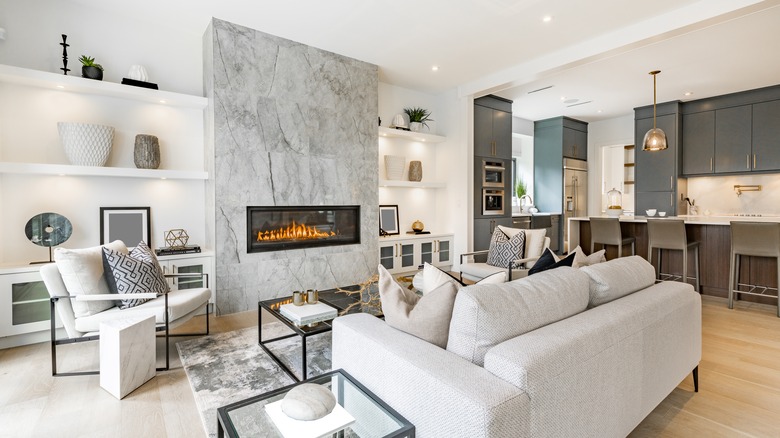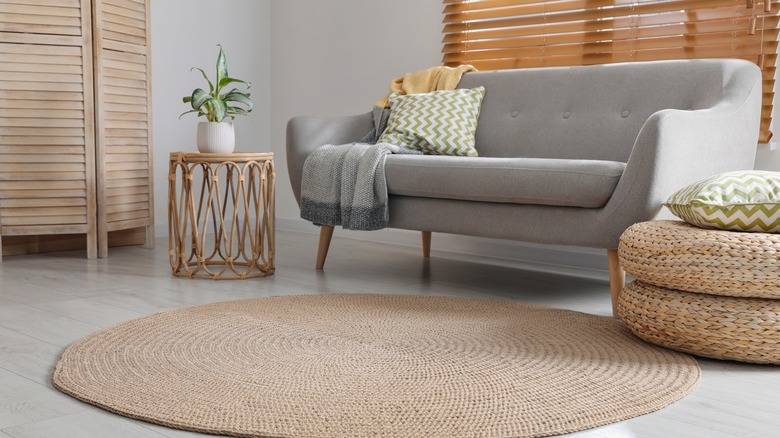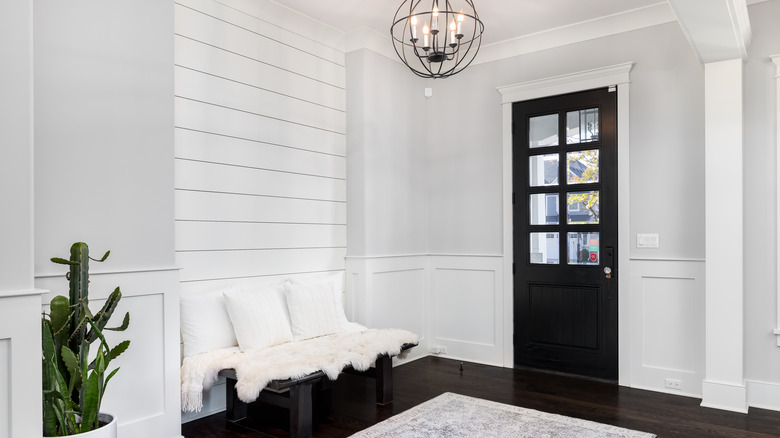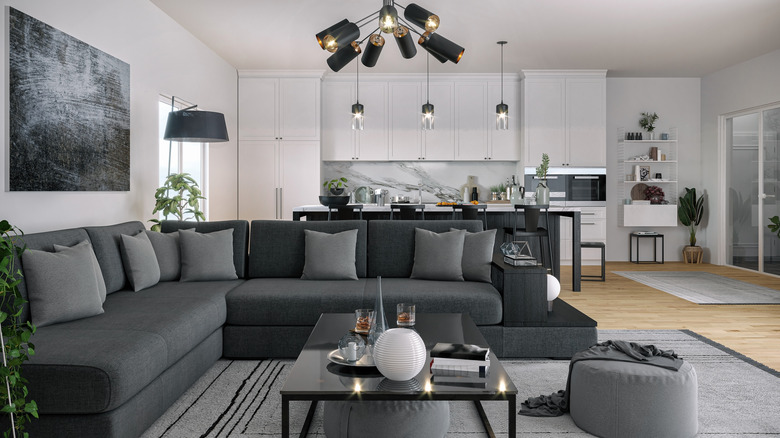What Interior Designers Really Think Of HGTV Renovations
HGTV was among the top ten most-watched television networks in 2022. Series like "Rock the Block" and "Home Town" are some of the most popular HGTV shows, with both programs focusing on renovating homes and designing stylish, practical living spaces. It's easy to see why these shows are so popular: Each offers a wealth of design inspiration, not to mention an inside look at what it takes to renovate a space.
While it's undeniable that people love HGTV, it's questionable whether the channel has a positive influence on viewers. Recent research indicates that home improvement media may be causing individuals to view their homes with a "market-reflected gaze," meaning they feel pressure to make their homes as palatable (read: neutral and inoffensive) as possible. "They're seeing everything that's wrong with their home and imagining when people come into their home [that] they're also criticizing and scrutinizing and judging their home," Annetta Grant, assistant professor of markets, innovation, and design at Bucknell University, told The Washington Post. "It really makes people feel quite uneasy about the decisions that they make in their home, and so they're always kind of fearful about getting it wrong."
With this new research in mind, have you ever wondered whether the designs on HGTV are actually on par with professional interior designers' standards? And what do professional designers think of HGTV shows, anyway?
HGTV shows may provide good design inspiration, but not renovation inspiration
Although many of us would love to completely renovate parts of our homes (we're looking at you, outdated kitchen!), the reality is that not everyone can afford to embark on the total 180-degree transformations you see on HGTV shows, which typically involve ripping out entire rows of cabinets and tearing down walls. But one of the great things about HGTV shows is that they can provide lots of inspiration if you want to take your décor or design in a new direction. Even if you can't afford to replace your island with a new marble slab, you may be able to find affordable alternatives inspired by the designs you've seen and loved on HGTV.
David Janovic, an interior designer and the CEO of RJ Living, agrees that this is one of the good things about the channel. "HGTV shows don't focus solely on renovations, but always have a strong design component, because not everyone has the budget or desire to renovate their home, but many people do want to refresh their décor or change their space through paint, furniture, and small projects," Janovic told The List.
Renovations are unrealistic in many ways
Some of the home design and renovation teams on HGTV shows make it look so easy to completely revamp your house. Although some series, such as "Good Bones: Risky Business," are transparent about construction delays and other snafus in the renovation process, other shows make it seem as though you can renovate and re-design an entire home in just a few days. But the truth couldn't be further from what you see onscreen, according to the Head of Interior Design at Renowell, Mariya Snisar.
"[HGTV shows] give unrealistic expectations and construction schedules," Snisar told The List. "Their struggle to cram a complete renovation into [a] 30-minute to 1-hour show is noticeable. The editing and condensing of one show to fit into one episode leads to a distorted and oversimplified portrayal of a renovation process."
Snisar also pointed out that the budgets are similarly "unrealistic." "I feel bad whenever clients come to seek my services, having saved some amount based on what they watched on TV, only to discover that the amount will only cover one aspect of the renovation project," Snisar shared. "The reality is that the figures don't paint an accurate picture of the cost of renovations. For shows like 'Fixer Upper,' they purchase products in bulk and utilize them on several homes, meaning they enjoy better deals compared to when buying for one house." Well, it's official: Our affordable renovation dreams are crushed.
Some shows can be fun and useful for those on a budget
Although some interior designers believe HGTV is too unrealistic to be helpful, others emphasize the fact that not all HGTV series are created equally. Although some may diss the formulaic nature of "Love It or List It," for example, others find joy in the fun hosts and creative designs on other shows.
Principal designer at Susan J Designs, Susan Wemlinger, shared with Insider that "Boise Boys" is a favorite of hers. The show, which first aired in 2017, focuses on two best friends who take Boise, Idaho, by storm with their home renovations. According to Wemlinger, the hosts are fun to watch, realistic about the renovation process, and demonstrate how to create unique designs on a budget. Wemlinger told the outlet that "Boise Boys" has one of the "most realistic budgets for their renovations that I've seen on a TV show," adding, "They also show the somewhat typical back and forth of the opposing viewpoints between the contractor and the designer."
Current HGTV shows lack renovations with a high-end finished product
In recent years, HGTV has placed an emphasis on shows that bring something interesting or unique to the table. For example, in the home reno show "Bargain Block," it's the host Keith's creative, avant-garde design aesthetic; when it comes to "Fixer Upper," it's modern farmhouse design schemes with some vintage twists. However, what's missing from these popular HGTV shows, according to interior designer Kesha Franklin, is a sense of luxury.
Franklin offers an older HGTV show, "Divine Design," as an example of a series that got it right. "Divine Design" aired from 2003 to 2011 and focused on transforming lackluster spaces into stylish, functional living areas. Franklin told Insider that the show "addressed the homeowners' issues regarding space and function," but also made sure the overall design was polished. "Despite some clear limitations and obstacles, the finished product always felt like a high-end, sophisticated, and luxe experience, which home renovation shows now lack," Franklin explained.
Series place too much emphasis on resale value
"The big problem with HGTV renovations is the focus on resale value," interior designer Michael O'Callaghan told The List. "Most of the renovations that you see lack will lack any expression of personality." O'Callaghan might be on to something: Watch any HGTV home reno show and you're likely to see a common theme in the homes that are designed to sell. These homes will likely feature light-colored walls, neutral wood or vinyl flooring, and neutral tones throughout the house. And while it's true that these features tend to appeal to a lot of people, they ultimately fall a bit flat.
"When you are encouraging everyone to follow the same gray color pallet and open plan design, you are going to lose that personal touch," O'Callaghan said. The designer also explained that a ripple effect can occur. "This creates a situation where every room that HGTV renovates ends up looking the same and it has such a strong influence on the people watching it that the homes around you end up reflecting the same style."
The timeline and price points are bogus
Interior designer Hannah Burcham told The List that, at the end of the day, HGTV shows are more about entertainment than they are about realistic home renovations. "Before going to design school, I thought HGTV shows like 'Love It or List It,' 'Property Brothers,' and 'House Hunters' were amazing. I would spend hours binge-watching these shows and dreaming about being an HGTV Star who would help people redo their homes in 2 weeks!" she shared. "But the truth is, these shows are not real and they give viewers a painfully unrealistic sense of what a renovation costs," she said, adding that "the timeline is misleading" and "client/designer relationships are pretty skewed."
Burcham also explained that the 50K budget and 2-month timeline you may see on "Fixer Upper" for a kitchen remodel, for example, is super unrealistic for a couple of reasons: First, you may end up waiting two months for a contractor's schedule to open up before starting the project. Second, she shared that factors like "product specification, city permitting, lead times, and scheduling conflicts" will likely come into play, slowing things down. Lastly, in many cases, $50,000 would not be enough to cover custom renovations.
But just because HGTV shows are unrealistic doesn't mean they aren't good TV. "All in all," Burcham said, "I think that as long as viewers can realize that the timeline and price points are bogus, then the shows are perfectly fun entertainment."
Interior designers don't consider HGTV real interior design
Most of us who don't have formal interior design training would agree that the designers on HGTV shows seem to do a pretty good job of jazzing up boring spaces. But for those with a trained eye, the designs and the shows aren't exactly as they appear.
Robin Burrill, who has been working as an interior designer for 38 years, told The List that the renovations you see on HGTV are "made for TV ... it's NOT real." Burrill explained, "Reality TV is made to get people to watch, to sell advertising," which is why the details of the renovations — like actual cost and project timelines — are frequently glossed over.
Still, Burrill does appreciate some HGTV shows. "The DIY shows are great, and I LOVE the ones that are truthful about how much longer it took, what all they ran into, and how much more it cost them," she shared. "These other shows by the bigger stars ... they're just not real, but homeowners think they are." Burrill went on to express her appreciation for Alison Victoria's honesty and design approach on "Windy City Rehab." "She does a good job showing true reality ... I loved her honesty with one of her partners or her project manager and how much money she was taken for ... now THAT is reality!!!"
It's refreshing to see historical charm preserved
While some guests who appear on HGTV are looking to modernize their spaces, others want to preserve the character of their homes by keeping older features. Shows like "Home Town" and "Flea Market Flip" are a few examples of HGTV shows that focus on restoring the old rather than introducing the new.
For interior designer Susan Wemlinger, focusing on maintaining the so-called "good bones" of a house and preserving certain components of the original design can be a balanced approach to interior design and home renovation. Wemlinger told Insider that HGTV shows like "Rehab Addict" "breathe new life into the home while keeping the original character intact and make it function better." She also noted that it's "refreshing" to see an interior design show where some of the old charm is left behind.
Wemlinger isn't the only person who wishes that HGTV hosts would focus more effort on preservation. One Redditor wrote, "It seems like now they are just buying plots and building the same cookie-cutter homes with different colors. Before they at least left the good bones and built around it."
Some shows set a good example of creativity and sustainability
Okay, so HGTV renovations may not be realistic when it comes to budgets and timelines, and not everyone is a fan of the design style that tends to be featured on the shows. But one positive aspect of many HGTV shows, according to interior designer Elizabeth Grace, is the focus on upcycling and using vintage items, which she told The List, "not only promotes sustainability but also adds a unique touch to each space."
Grace shared that "Fixer Upper" is a good example of a show that incorporates an old-meets-new design scheme. "Exquisite shiplap accents, reclaimed wood elements, and vintage decor create an ambiance that echoes the grace of bygone eras. 'Fixer-Upper' thrives on the concept of marrying the old with the new, resulting in spaces that exude warmth, comfort, and a touch of nostalgia," Grace explained. Comparing "Fixer Upper" to another popular HGTV show, "Good Bones," Grace said both shows can serve as excellent creative design inspiration. "'Fixer Upper' embraces the nostalgia of timeless charm, while 'Good Bones' takes us on an audacious journey of creative exploration. As an interior designer, I believe that both shows offer invaluable insights into the vast possibilities that the world of design has to offer," she said.
HGTV renos generally feel sterile
There's a delicate balance between appealing to a broad audience and, well, making all of your designs look the same. One person on Reddit felt that even "Good Bones" — a show known for its eclectic touches — veers too far into boring, predictable design schemes. "They ripped down [a] 1940s home with CHARACTER ... just replaced it with gray on gray on marble with veins and shaker cabinets ... It's just boring," the Redditor wrote.
Some interior designers agree with this take. "[HGTV's] constant push of trends like open-concept living rooms and an obsession with gray laminate floors paired with white quartz countertops creates a homogenous, sterile aesthetic," said Zach Dannett, co-founder of Tumble, a platform offering curated home furnishings. Interior designer Robin Burrell is also sick of the trendy designs: "If I hear shiplap one more time, I'm going to scream," she told The List. "Or [if I] see a beige/grey/off-white/white room by Studio McGee, I'm going to throw buckets of primary paint colors into it!"
Good interior design draws from a variety of sources
If it's not clear by this point, plenty of interior designers are divided in their opinions of HGTV shows. Some believe these series lack character in their designs; others can simply appreciate the entertainment factor that the shows offer. But can our favorite HGTV shows offer useful inspiration, or are they too trends-focused to offer timeless design insight?
According to interior designer Murat Yashar, the best way to design and decorate a space is by taking the time to curate your own personal aesthetic — not relying solely on HGTV trends for reference. "As a designer, I encourage you to draw inspiration from a variety of sources, such as HGTV shows, interior design magazines, and online resources," Yashar told The List. "Creating a space that reflects your personality, lifestyle, and preferences is ultimately the key to a successful and gratifying interior design."
HGTV hosts aren't treated like other interior designers in the industry
Not all the hosts of your favorite HGTV shows are actually interior designers. Many of them are design enthusiasts, realtors, "flippers," or hold other home-renovation-related titles. However, many of these hosts, while not formally trained or licensed, act as interior designers, coming up with design schemes, hiring teams to implement their ideas and renovations, and, overall, doing the same thing actual interior designers do.
However, according to interior designer Robin Burrill, some HGTV hosts don't receive the same treatment as other industry professionals. In fact, they often enjoy special privileges — or, at least, Chip and Joanna Gaines have, according to Burrill. "What people don't know is that the Gaines' were fined by the EPA because they weren't certified to do LEED remediation or asbestos and goodness knows what else," Burrill shared. "Those of us in the industry felt like they got a slap on the wrist for all the violations they committed. And what about permits? Engineering plans? This is never talked about!" Clearly, there are still issues to work out between the world of HGTV and real-life interior designers.

